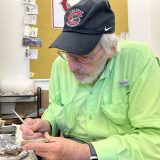Schmid SURF Students Make Waves Summer research in the Keck Center is busier than ever!
July 18, 2019
Thanks to Chapman’s Center for Undergraduate Excellence (CUE), Schmid undergraduate students have the opportunity to pursue research under the guidance of full-time faculty mentors during the summer. This Summer Undergraduate Research Fellowship (SURF) is a paid, on-campus summer fellowship with a faculty member that includes monetary support and on-campus housing. Students from all of Chapman’s disciplines are invited to apply.
The program spans 8 weeks during the summer. Fellows are expected to perform an average of 30 hours of research or creative activity per week during the SURF program and are required to attend faculty lectures and professional seminars twice a week throughout the program.
We caught up with our Schmid students participating in the program to see how their summer research was going.
SCHMID SURF FELLOWS
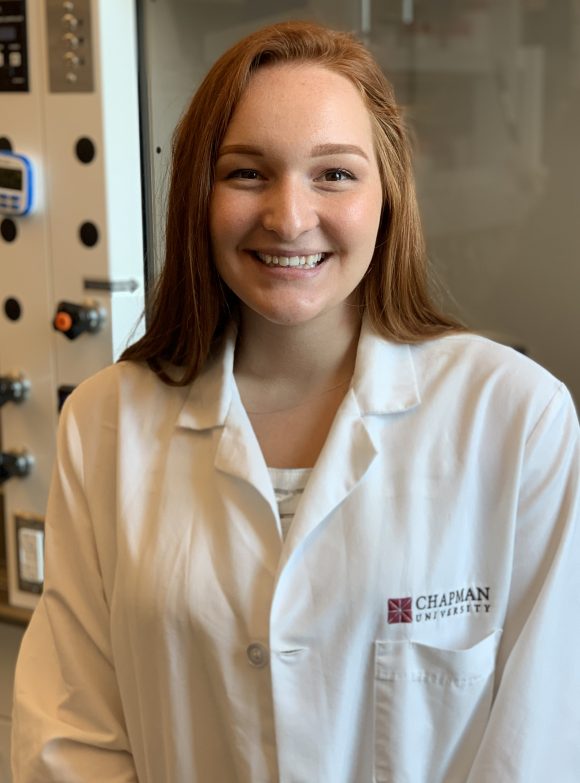 Cara Fleener, junior biochemistry & molecular biology major
Cara Fleener, junior biochemistry & molecular biology major
Faculty Mentor: Dr. Allegra Liberman-Martin
Project: “This research project focuses on designing an economical, earth-abundant, and non-toxic catalyst containing the main group element, phosphorous. We are exploring a new carbodiphosphorane catalyst and observing its effectiveness in catalyzing ketone hydroboration reactions. I chose this research project to focus on since I really enjoyed my organic chemistry class with Dr. Liberman-Martin last semester. I was interested in expanding my learning to a more practical environment, so I can apply the concepts I learned in class to research that has the potential to impact real-world issues. This research encompasses chemical synthesis, NMR data analysis, and applying structural and reactivity concepts to mechanistic conclusions. Gaining experience in these research techniques will better prepare me for graduate school research.” – Fleener
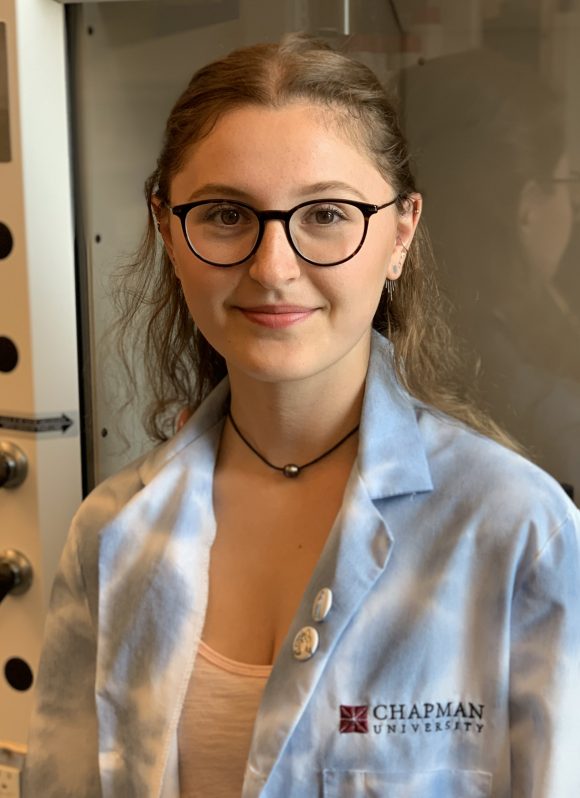 Roxanne Naumann, junior chemistry major
Roxanne Naumann, junior chemistry major
Faculty Mentor: Dr. Allegra Liberman-Martin
Project: “We’re researching renewable polymer synthesis. We’re trying to make a cheap, safe, and abundant catalyst that can polymerize monomers without much dispersity. Plastic is killing the Earth. Okay, to be fair, lots of things are killing the Earth, but plastic is in the top tier of awful. Since the only biodegradable plastic alternative on the market is far too brittle for the wide-scale manufacturing that the world needs, we’re out to make a better one. Specifically, we’re trying to make the catalyst that could polymerize whatever monomers can be used for a biodegradable plastic. You see, every polymerization reaction requires a catalyst (that is, in order to make plastic, the reaction needs a catalyst), and current catalysts are made with harmful, expensive, and non-abundant elements such as palladium. We’re trying to make a catalyst out of silicon because it’s safer, cheaper, and naturally abundant. If we accomplish this, the biodegradable plastic industry will have the groundwork laid for wide-scale manufacturing. Basically, we’re trying to save the world, but who isn’t?” – Naumann
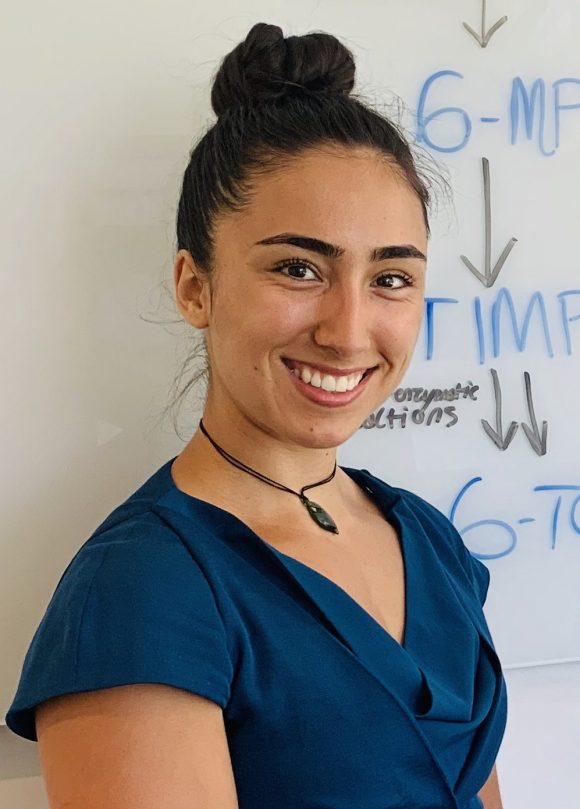 Natalie Paterson, senior biochemistry & molecular biology major
Natalie Paterson, senior biochemistry & molecular biology major
Faculty Mentor: Dr. John Miklavcic
Project: “Using an international database from the ImporveCareNow network and our local collaboration with Dr. Kenneth Grant, MD, Head of Pediatric Gastroenterology, at Children’s Hospital of Orange County, we aim to investigate the health outcomes of children with IBD through combining folic acid supplementation (an essential nutrient) with the drug azathioprine in order to mitigate drug-induced toxicity and to allow all children to benefit from the treatment. I am passionate about understanding the intricate chemical mechanisms of metabolism and how our individual genetic makeup can influence and is affected by the composition of our nutritional and medicinal intake. This project aims to connect the potency of functional foods (folic acid) with that of modern technology (the drug azathioprine) to create a harmony that personalizes the children’s treatment plan and allows them to sustainably manage their disease.” – Paterson
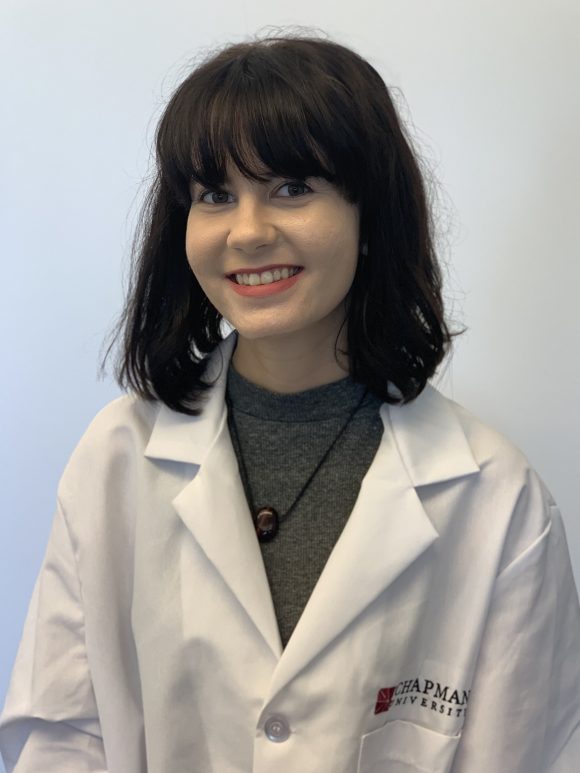 Heidi Standke, senior biochemistry & molecular biology major
Heidi Standke, senior biochemistry & molecular biology major
Faculty Mentor: Dr. Cedric Owens
Project: “My research examines the regulation of the enzyme Nitrogenase. In short, plants have a difficult time utilizing the dinitrogen in our atmosphere to create such things as their DNA and proteins. This is why fixed-nitrogen in the form of ammonia contained in fertilizers are often supplied to plants. However, the production of fertilizers is expensive and contributes to the emission of greenhouse gas. We are examining the possibility of a bio-fertilizer by looking at the bacteria Gluconacetobacter diazotrophicus which contains the enzyme Nitrogenase that can convert the dinitrogen in the atmosphere to ammonia which plants can then utilize. But before Nitrogenase can be used as a biofertilizer, it is essential that we understand how this enzyme is regulated, as in what conditions this enzyme works best in. Nitrogenase is regulated by the protein NifA, which “turns on” Nitrogenase by binding to DNA through its DNA binding domain. I am looking at this DNA binding domain of NifA in order to determine the conditions in which it binds to DNA and hence activates Nitrogenase transcription.” – Standke
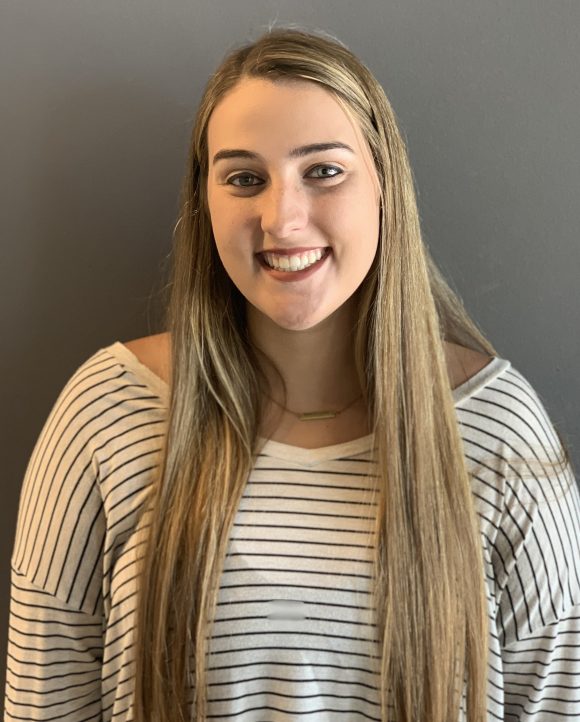 Lindsay Zumwalt, senior biological sciences major
Lindsay Zumwalt, senior biological sciences major
Faculty Mentor: Dr. Maduka Ogba
Project: “My project is focused on the bacterial pathogen Helicobacter pylori. About half of the world’s population is affected by this pathogen. It is known to cause chronic inflammation of the stomach, otherwise known as gastritis, which can trigger diseases such as ulcers and cancers. The excretion of reactive oxygen species, such as HOCl, from immune cells during inflammation is a common defense mechanism used by the human body to eradicate such bacteria. Not only is H. pylori resistant to HOCl, it navigates towards the site of inflammation to colonize and extract iron from the host. H. pylori consists of four chemoreceptors – TlpA, TlpB, TlpC, and TlpD – that detect the environment around it and respond with changes in flagellar movement. Previous mutation studies have shown that TlpD is responsible for the chemoattractant response and efficient colonization. Within TlpD is a chemoreceptor zinc binding (CZB) site, the second most prevalent domain found in cytoplasmic chemoreceptors, which consists of a Zn2+ surrounded by three histidine (His) and one cysteine (Cys) residues. Our understanding of the mechanism in which the CZB domain senses HOCl from inflammation is still in its infancy. Understanding this mechanism provides crucial insight needed to discover new therapies to eradicate this pathogen. The goal of this work is to use computations to uncover (i) the mechanism of HOCl-mediated cysteine oxidation within the Zn-binding core of TlpD, a chemoreceptor in Helicobacter pylori, and (ii) the origins of selectivity for HOCl over other oxidizing reagents such as H2O2 and O2. I could not imagine a project more aligned with my interest in the intersection of organic chemistry, technology, and the medical field.” – Zumwalt
Q&A
Q: What have you learned so far from this opportunity?
“I have learned how to be a more independent researcher, while also learning the importance of asking questions.” – Cara Fleener
CF: “So far, I have learned how to interpret data using an NMR, use a Schlenk line to degas liquids, use antechambers for the glovebox, and general synthesis and reaction techniques. I have learned how to be a more independent researcher, while also learning the importance of asking questions.”
RN: “Working with air and water sensitive materials makes for long and tedious lab days. I’ve learned a lot of patience and new techniques for handling all sorts of reagents. I’ve learned what real lab work is like. Seems like a rather silly statement, but a real lab is so different from o-chem or gen-chem lab. We’re not doing anything with a set procedure or looking for any specific outcome because a lot of times, what we’re doing is partially guesswork. And it’s amazing.”

Natalie Paterson works on her research data set.
NP: “As we are working with a large data set to answer our research questions, I have had to quickly familiarize myself with the various intricacies of different data software and how to utilize their applications. What’s more, I have seen firsthand what the interdisciplinary collaboration of departments can deliver. Due to our data set having various layers of complexity we requested assistance from Erik Linstead of the Computational and Data Sciences division here at Chapman to transform the information into a form that is easier to decode. Overall, through this experience, I am learning how complementary expertise can work synergistically to achieve objectives. It is truly refreshing to see how the Chapman community supports each other to continuously create a positive impact on both the local and wider community.”
HS: “I’ve learned so much during my research experience. For example, I know the process and procedure it takes to study a protein. I’ve learned to express and purify my protein construct and conduct assays to study the DNA binding of NifA. Personally, it was through this research experience that I became confident that the field of research is one that I want to pursue. This Fall I will be applying to graduate school to continue my education and continue my path to becoming a researcher.”
LZ: “I have gained experience and become significantly more comfortable in the field of computer science. I also have become more confident in my presentation skills and explaining scientific concepts as we present weekly in lab meetings.”
Q: How do you like working in the Keck Center?
“I am so grateful to the continual investment that Chapman puts towards enhancing the sciences and bridging the gap between textbook knowledge and real-world application.” – Natalie Paterson

Cara Fleener working in research lab in the Keck Center.
CF: “Working in the Keck laboratories has allowed me to gain exposure to more professional lab spaces. Our particular lab contains a nitrogen glovebox which provides an environment without air or water. This is necessary for our research because my catalyst is air and water sensitive.”
NP: “Keck is a home away from home to me! It may sound crazy, but I feel like a genius simply being in the building itself. I am so grateful to the continual investment that Chapman puts towards enhancing the sciences and bridging the gap between textbook knowledge and real-world application. I am proud to represent Chapman and the work we do here because it is constantly evolving and always challenges us to think and act both critically and creatively in every task. All in all, through our experiences here we are being shaped into well-rounded young adults equipped with the necessary skills to tackle our next big chapters in life.”

Lindsay Zumwalt working on research in the Keck Center.
HS: “I love it, it’s so nice! There are a couple of machines I do use frequently during my research. I use a circular dichroism spectrometer to study the folding of the protein construct and I also use a fluorescence spectrometer to perform fluorescence quenching experiments to look at the DNA binding of NifA.”
LZ: “I love working in Keck. Since we are a computational lab and do not have a specific “research laboratory”, the study spaces available in Keck are extremely useful. A lot of our work uses the cluster in Keck which is an incredible piece of technology that makes this research possible. The computing power of this technology is a key component of this work.”
Q: What else should we know about the SURF program?
“CUE (Center for Undergraduate Excellence) has been an incredible resource on campus and I am very grateful for both the opportunity to research during the school year and being granted this fellowship.” – Lindsay Zumwalt
CF: “Not only does this fellowship give me the means of continuing my research over the summer, but it also provides weekly professional development meetings. These meetings are very helpful in motivating students to really make the most of their education and resources here at Chapman.”
NP: “Before coming to Chapman, I never knew or understood the significance of what engaging in a research opportunity meant. Not only is it favorable for various graduate school, internship, or job opportunities going forward but it is truly impactful in showing you what your interests look like in action. For instance, even if you take on a research experience and realize by the end of it that such work isn’t for you, that insight is extremely valuable. No matter what, gaining experience of any kind is one of the easiest ways to increase your confidence in the decisions you make for your future.”
LZ: “I would like to give a huge shoutout to both Dr. Ogba and the Center for Undergraduate Excellence (CUE) for this amazing opportunity. Dr. Ogba has been one of my biggest supporters at Chapman and is always there to help guide us through our research and challenge us intellectually. The CUE has been an incredible resource on campus and I am very grateful for both the opportunity to research during the school year and being granted this fellowship.”
Interested in participating in the SURF program?
To learn more about the program requirements and application process, click here >>
The Center for Undergraduate Excellence is located at 415 East Walnut Avenue. Orange, CA 92867. You can email them at cue@chapman.edu or call at (714) 628-2852.

